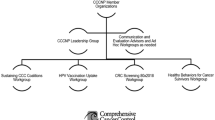Abstract
The comprehensive cancer control approach is used by state, tribes, tribal organizations, territorial and Pacific Island Jurisdiction cancer coalitions to spur local implementation of cancer plans to reduce the burden of cancer in jurisdictions across the country. There is a rich diversity of models and approaches to the development of relationships and scope of planning for cancer control activities between coalitions and advocates in local communities. The national comprehensive cancer control philosophy provides an operational framework while support from the Centers for Disease Control and Prevention enables coalitions to act as catalysts to bring local partners together to combat cancer in communities. This manuscript describes multiple characteristics of cancer coalitions and how they are organized. Two models of how coalitions and local partners collaborate are described. A case study method was used to identify how five different state and tribal coalitions use the two models to organize their collaborations with local communities that result in local implementation of cancer plan priorities. Conclusions support the use of multiple organizing models to ensure involvement of diverse interests and sensitivity to local cancer issues that encourages implementation of cancer control activities.
Similar content being viewed by others
References
Edwards BK, Ward E, Kohler BA et al (2009) Annual report to the nation on the status of cancer, 1975–2006, featuring colorectal cancer trends and impact of interventions (risk factors, screening, and treatment) to reduce future rates. Cancer 116:544–573
National Cancer Institute (2010) Milestone 1971 The National Cancer Act. http://dtp.nci.nih.gov/timeline/noflash/milestones/M4_Nixon.htm. Access 21 May 2010
Brinkley WR, Wood J, Garrison HH (1988) Increased funding for NIH: a biomedical science perspective. FASEB J 12:1431–1435
Herin M (2010) Deaths: Leading causes for 2006. National vital statistics reports. http://www.cdc.gov/nchs/data/nvsr/nvsr58/nvsr58_14.pdf. Accessed 21 May 2010
Deaths, percent of total deaths, and death rates for the 15 leading causes of death: United States and each state, 2005. Atlanta (GA): Centers for disease control and prevention; 2008. http://www.cdc.gov/nchs/data/ dvs/LCWK9_2005.pdf. Accessed 17 April 2010
Lisovicz N, Wynn T, Fouad M, Partride E (2008) Cancer health disparities: what we have done. Am J Med Sci 335(4):254–259
Frieden TR, Myers JE, Krauskopf MS, Farley TA (2008) A public health approach to winning the war on cancer. Oncologist 13:1306–1313
Given LS, Black B, Lowry G et al (2005) Collaborating to conquer cancer a comprehensive approach to cancer control. Cancer Causes Control 16(Suppl.1):3–14
Friedman C (2009) The promise of comprehensive cancer control. Preventing chronic disease 6 http://www.cdc.gov/pcd/issues/2009/oct/09_0085.htm. Accessed 24 May 2010
C-Change. Ten year history supported by the CCC national partnership. http://www.c-changetogether.org/pubs/pubs/Comp_Cancer_Ctrl_10Yrs.pdf
Koh HK, Walker DK (2003) The role of state health agencies in cancer prevention and control: lessons learned from Massachusetts. Cancer Epidemiol Biomarkers Prev 12(3):261s–268s
Georgeson M, Thorpe LE, Medino M et al (2005) Shortchanged? An assessment of chronic disease programming in major US city health departments. J Urban Health 82:183–190
Frieden TR (2004) Asleep at the switch: local public health and chronic disease. Am J Public Health 94:2059–2061
Himmelman AT (2001) On coalitions and the transformation of power relations: collaborative betterment and collaborative empowerment. Am J Community Psychol 29(1):277–284
Author information
Authors and Affiliations
Corresponding author
Additional information
The findings and conclusions in this report are those of the authors and do not necessarily represent the views of the Centers for Disease Control and Prevention.
Rights and permissions
About this article
Cite this article
Behringer, B., Lofton, S. & Knight, M.L. Models for local implementation of comprehensive cancer control: meeting local cancer control needs through community collaboration. Cancer Causes Control 21, 1995–2004 (2010). https://doi.org/10.1007/s10552-010-9655-x
Received:
Accepted:
Published:
Issue Date:
DOI: https://doi.org/10.1007/s10552-010-9655-x




